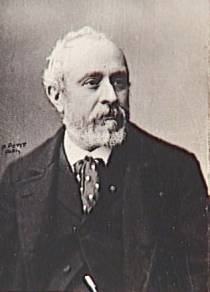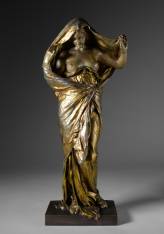BARRIAS Louis-Ernest
BARRIAS Louis-Ernest
Louis-Ernest Barrias came from a family of artists. His father was a porcelain painter and his older brother, Félix-Joseph Barrias (1822-1907), was a well-known painter. Louis-Ernest Barrias oriented himself towards artistic studies. He entered the École des Beaux-Arts in Paris in 1858, first with the sculptor Jules Cavelier and the painter Léon Cogniet, then with François Jouffroy. Second Prize of Rome in 1861 for Chryséis returned to her father by Ulysse, he obtained the Prize of Rome in 1865 with The foundation of Marseille and was hired on the construction site of the Paris Opera.
Barrias stayed at the French Academy in Rome and "became one of the most brilliant hopes of the French school of sculpture" on his return to France: if, notes Françoise Cachin, "Paul Dubois, Henri Chapu and Alexandre Falguière constitute the core of what is called the neo-Florentines", Louis-Ernest Barrias is indeed among those who, following them, "became convinced that the 15th century is not as Gothic as one would like to say and that the Donatellos, Andrea del Verrocchio, Mino da Fiesole, Bernardo Rossellino and other barbarians have seen clearly enough into the human soul: following this unexpected discovery, an evolution was made in the ideal. The sculpture became alive again".
It is in this context that we observe that Barrias' The Oath of Spartacus "offers, in the body of the supplicant, an echo of Michelangelo's Entombment in the Duomo of Florence". He then produced numerous sculpted works, most of them in marble. In 1881, he was awarded a medal of honor of the fine arts and named knight of the Legion of Honor in 1878, then promoted to officer in 1881 and commander in 1900. The artist replaced Auguste Dumont at the Institute in 1884, then succeeded Jules Cavelier as professor at the Beaux-Arts de Paris, where, among his most notable students, were Victor Ségoffin, Charles Despiau and Paul Landowski.
He had three children: Paul (1875-1973), who would become a renowned architect, winner of the 2nd Second Grand Prix de Rome in 1901; Daniel (1883-1969), who would embrace a military career; and Madeleine (1877-1925).
Louis-Ernest Barrias died of a cold on February 4, 1905 at his home at 9, avenue des Chasseurs in the 17th arrondissement of Paris. He is buried in Paris in the cemetery of Passy (8th division).
Some of his work can be seen in public places in Paris, at the Musée d'Orsay or at the Père-Lachaise cemetery.


